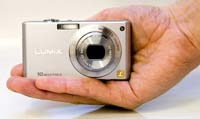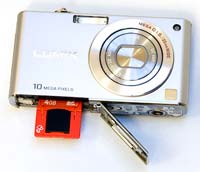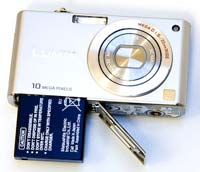Panasonic Lumix DMC-FX37 Review
Review Date: December 11th 2008
Author: Mark Goldstein / Gavin Stoker
Leave a comment about this review
|
Introduction

The Panasonic Lumix DMC-FX37 is a small and light compact camera aimed firmly at the point-and-shoot user. At first glance the FX37 is rather unassuming, with "only" 10 megapixels, a standard 2.5 inch LCD screen and understated styling, but there are a couple of stand-out features. The 5x zoom lens is the main one, an unusually versatile focal range on such a small camera, but even more so when you find out that the Panasonic FX37 offers a wide-angle setting of 25mm. The second is the ability to shoot high-definition 1280 x 720p video at 30 fps, a feature retained from the previous FX35 model but still something of a rarity in this class of camera. Other improvements from the FX35 are more subtle - extra Pin Hole, Film Grain and Flash Burst scene modes, addition of AF Tracking to the beginner-friendly Intelligent Auto shooting mode, improved battery life and four additional colours are the main additions. The new Panasonic DMC-FX37 has an official list price of �249 / $399. We find out if the DMC-FX37 is a worthy addition to Panasonic's extensive range of stylish compact cameras.
Compare Prices
Support PhotographyBLOG: Buy the Panasonic Lumix DMC-FX37 from one of our affiliate retailers:Ease of Use
Panasonic's compact digital camera range is a better starting point than most for the absolute beginner, with intelligent auto functions switching shooting modes for you depending on the subject, plus optical image stabilization (Mega OIS) on board as standard to help avoid unwanted camera shake. With a mainly metal build, the diminutive Lumix DMC-FX37 updates the FX35 model and is a solid feeling if unassumingly oblong addition to the range, marrying the above features to a 10.1 megapixel resolution for a manufacturer's asking price of �249 / $350. With some retailers price cutting 10 megapixel models to around �125 / $200 however, it feels like a price tag of �199 would be nearer the mark for the slim-line FX37 � and indeed most 'e-tailers' were offering it for around �50 / �100 less than that the launch price at the time of writing, making it a much more attractive proposition.
Hand-holding point-and-shoot features aside, what immediately stands out on the FX37 is the very versatile 25mm wide-angle 5x optical zoom lens (extending up to an equivalent of 125mm in 35mm terms), which is as perfectly suited to group party photos as it is landscapes, though the latter do more noticeably suffer from barrel distortion and converging verticals. Panasonic have been leading the way on introducing wider-angle lenses, with 30mm or less now standard on all of their cameras - remember the (recent) days when 35mm was as wide as lenses got? The increase from the FX35's 4x zoom to the FX37's 5x lens is also very welcome, giving you a little more reach at the telephoto end.
Round the back of the pocket sized Panasonic FX37 are a slightly-improved 2.5-inch LCD screen with 230k dots, auto brightness control and wider viewing angle than on the FX35. Raising the bar much higher is a 1280x720 pixels High Definition movie mode that will instantly appeal to those who own one of Panasonic's HD Viera TV sets. There's also light sensitivity all the way up to an initially impressive ISO 6400 in High Sensitivity scene mode if you don't mind resolution dropping down to three megapixels, with up to ISO 1600 manually selectable at full resolution. The intelligent exposure function claims to control ISO in such a way that shadow area is brightened without it adversely affecting the whole scene � evening out exposures much like Sony Cyber-shots D-range Optimiser or Nikon's correctional D-Lighting � but in practice highlight detail can be lost.
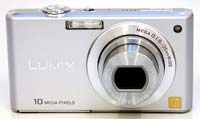 |
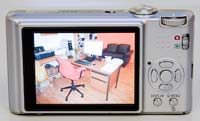 |
| Front | Rear |
While the front of the FX37, at least in its silver incarnation (black, blue, pink, white and brown are also available), is fairly plain, it's not unattractive, dominated by a stubby lens barrel with Leica optics, top left of which is a thin sliver of a window for the built-in flash. On the other side of the lens is a porthole for the self-timer indicator and AF assist lamp � and, apart from plenty of branding, that's basically it for the front of the camera.
Similarly spare in terms of design flourishes is the top of the FX37, featuring a springy shutter release button as its most obvious attribute. This is encircled by a spring-loaded lever for operating the zoom, and, alongside, is a small circular on/off switch marked as such. Along from this again are a tiny pinprick for the built-in microphone and a row of four dots indicating an integral speaker. Flick the power switch with a fingertip and the FX37 powers up in a couple of seconds, a standard performance for its class, the rear LCD blinking into life and the formerly hidden lens barrel extending outwards to maximum wide-angle setting. With a half press of the shutter release button the FX37 takes a second or so to determine focus or exposure, signaling this with a beep of confirmation (this can be turned off). Images are committed to memory in a couple of seconds, the screen momentarily blacking out and then freezing while the process is taking place.
As expected in the absence of any optical viewfinder the back of the FX37 is dominated by that 2.5-inch, 230k dot screen which delivers adequate visibility both indoors and out. Unlike the solid look and feel of the front and top of the camera, the back presents some distinctly plastic looking buttons however. Nestling into the top right hand corner of the camera back we find a partially recessed thumb-operated mode dial featuring five distinct function settings. Starting with intelligent auto mode (IA) and moving anti-clockwise we come to normal picture mode (regular auto), followed by scene mode, motion picture/video mode and finally clipboard mode, the latter allowing the recording of memos.
|
As with previous generations of Lumix, intelligent auto mode (IA) is supremely reliable, swapping in an instant from, for example, macro to landscape with a move of an arm (or tripod) and a half press of the shutter release button. This allows users, inexperienced or otherwise, to concentrate on both subject and composition rather than what the camera is doing. Intelligent Auto also now incorporates AF Tracking, helping you to keep up with your fast-moving children and still get an in-focus picture. For those who can be trusted to select the likes of macro for themselves, the normal (auto) picture mode is the setting to leave the camera on, while the 26 icon-led pre-optimised scene modes cover all common bases from portraits through to underwater photography (an underwater housing accessory is available). Suggesting that this is a model that is aimed squarely at family use, there are not one but two baby portrait modes, plus a dedicated pet mode. The new Pin Hole and Film Grain scene modes create retro film-camera-like effects, while the Flash Burst mode allows continuous firing of the flash during continuous shooting (but sadly only at 3 megapixel resolution).
Beneath the mode dial on the camera back is a square of nine raised plastic nodules that provide a degree of purchase for the thumb when the camera is gripped in your right hand. Ranged alongside is a slider control for flicking between image capture (denoted by the familiar camera icon) and playback (signaled by the equally unambiguous 'play' triangle). Though it's obvious what this switch is for, unlike some pocket camera systems with a dedicated button for playback instead, here users cannot immediately return to capture mode with a half press of the shutter button. So, should a picture opportunity present itself while the camera is still in review mode, it could be lost.
In the middle of the control layout we find a four-way controller with four separate buttons instead of a pivoting pad, at the centre of which is the regular menu/set button. Used to tab through onscreen menu items or images in playback, a press of the top button when in capture mode brings up an exposure compensation slider on screen with the ability to adjust between +/- 2EV. The button immediately beneath is for switching to the aforementioned macro mode for shooting subjects as close as 5cm, the button on the left for selecting self-timer modes, while the one to the right of the menu/OK button is for selecting flash mode options, most coupled with red eye reduction.
Press the menu button within capture mode and you're rewarded with both shooting and set up folders appearing onscreen. Within the record menu, users have the ability to alter aspect ratio from 4:3 to 3:2 or 16:9, access ISO sensitivity plus a wide range of colour modes, stretching from the perfectly adequate default of 'standard' through natural, vivid and B&W, to sepia, cool and warm settings. Within the set-up menu a live histogram can be called up on screen to check exposures before firing the shutter. Nothing revolutionary perhaps, but most of the boxes are ticked for a compact in this price bracket.
|
We're not done for buttons yet though, as the final two resting near the camera base are marked with the self explanatory 'display' and the less familiar 'Q.menu' � not a 'quality' menu as first might be assumed, but a 'quick menu' that summons up a drop-down toolbar running across the top of the LCD screen. As it indicates, this allows rapid access to the likes of white balance and resolution without having to otherwise navigate separate menu folders.
Moving from the FX37's back over to its left hand flank we find no features at all, while the right side has a pull-open flap covering three ports. From the top these are a component out socket for hooking the FX37 up to a TV set via optional cable, a USB/AV out socket for attaching the camera to your computer or PictBridge enabled printer or TV set via a conventional AV cable, and thirdly a DC-in socket for using the camera with an optional AC mains adaptor. Above this compartment is an eyelet for attaching the provided wrist strap.
Up-ending the camera and examining the base, we find a screw thread for fixing the FX37 to a tripod, rather inconveniently located to the far-left, alongside which is a flimsy but lockable compartment that houses both rechargeable lithium ion battery and removable (optional) SD memory card. This is backed up with 50MB internal memory to get you started out of the box, while Panasonic claims the battery itself is good for 310 pictures fully charged, though ours seemed to run out nearer to the 250 picture mark.
While the above is pretty much what you'd expect to find on a digital snapshot camera, with precious few surprises either welcome or nasty, how does the resulting image quality measure up? Can users expect a treat in store or a sting in the tail?
|
![]() PhotographyBLOG
is a member of the DIWA
organisation. Our test results for the Panasonic Lumix DMC-FX37 have been submitted to DIWA
for comparison with test results for different samples of
the same camera model supplied by other DIWA
member sites.
PhotographyBLOG
is a member of the DIWA
organisation. Our test results for the Panasonic Lumix DMC-FX37 have been submitted to DIWA
for comparison with test results for different samples of
the same camera model supplied by other DIWA
member sites.


